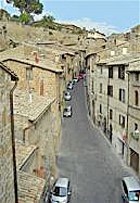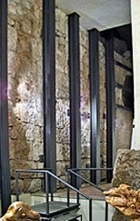


Orvieto, the probable site of Urbs Vetus
Since the time of Karl Müller (referenced below), some scholars have suggested that the situation at Volsinii in 264 BC was probably similar to that at Falerii some 23 years later: on this latter occasion, the Romans destroyed the old city and moved its citizens to a less easily defended site on the plane below. The old city was repopulated in the 8th century AD, when its more easily defended position had obvious attractions. However, Roman Falerii continued to exist, so the repopulated city adopted a new name, Civita Castellana. On this theory, pre-Roman Volsinii was repopulated in similar circumstances and given a new name, “Urbs Vetus”.
The diocesan histories of “Volsinii” and “Urbs Vetus” provide some support for this hypothesis:
-
✴In 494, Pope Gelasius I wrote to Secundino, whom he addressed as “ep. Vulsinien” (bishop of Volsinii, i.e. Bolsena).
-
✴In 590, Pope Gregory I wrote to Giovanni, whom he addressed as bishop of “Urbe vetere”.
-
✴ Giovanni’s successor, Candidus, appears in the papal registers shortly thereafter:
-
•in 591, as bishop of “Urbe vetere”;
-
•in 595, as bishop of “civitas Bulsinensis”; and
-
•in 596, as bishop of “Urbe veteri maior”.
It seems therefore that Urbs Vetus had grown in importance and achieved diocesan status during the 6th century, and that it was merged (possibly as the senior partner) with the older and probably adjacent diocese of Volsinii in ca. 596 AD.
We have two accounts of the travails of an Etruscan city called Urbs Vetus in the 6th and early 7th centuries:
-
✴Procopius of Caesarea, in his account of the Emperor Justinian’s wars against the Goths in Italy, described Belsarius’ siege and capture of Οὐρβιβεντὸς (Urviventus, probably a corruption of “Urbs Vetus”) in 538 AD:
-
“Belisarius went round the city to see if he could spy out any place suitable for an assault, but came to the conclusion that it was impregnable by open attack, though it might perhaps be taken by some well-contrived stratagem. For it rises, a solitary hill out of a hollow country, evenly sloping and level above, but precipitous below. But round this hill other cliffs of the same height range themselves in a circle, not in the immediate neighbourhood, but about a stone's throw distant. On this hill, the men of old founded a city, but did not surround it with walls or any other kind of fortification, thinking that Nature had herself made it impregnable. For there is only one way of access to it from the heights and, if this is guarded, the defenders need fear attack from no other quarter. For round all the rest of the city, except this one point, runs a broad and unfordable stream filling up the chasm between the city and the surrounding eminences. A little fortress was accordingly erected by the Romans of old at this point of access, and in it is a postern gate that was guarded by the Goths. Belisarius therefore ranged all his army round the city, on the chance of effecting something against it by the way of the river, but having also some hope that the enemy would be compelled to surrender by hunger”. This, apparently, is what actually occurred.
-
✴Paul the Deacon, in his “Historia Langobardorum”, summarised the Lombard attack on Byzantine Italy in ca. 605-10 AD as follows:
-
“Afterwards ... [the Lombard] king Agilulf made peace with Smaragdus the [Byzantine] patrician for one year, receiving from the Romans 12,000 solidi. Cities of Tuscany too, i.e. Balneus Regis and Urbs Vetus, were seized by the Lombards. ... Afterwards king Agilulf again made peace with the Romans for 3 years” .
-
This city could conceivably have been Orvieto: excavations of the city reveal that it had, indeed, been repopulated at some time in the 6th century. Nevertheless, as George Dennis made clear in a footnote to the account quoted above, there are problems associated with this theory. He was specifically concerned about Procopius’ statement that the hill on which Urbs Vetus stood was “surrounded by rocks of equal altitude, not quite close, but about a stone's throw distant ...” This, he claimed, “is not at all characteristic of Orvieto, whose complete isolation ... is its distinctive feature, and from which the nearest of the surrounding heights can hardly be less than a mile distant. The description seems to be written by one familiar with the spot; and this confirms me in the opinion that it is not Orvieto to which it refers”.
By contrast, Thomas Hodgkin, in his seminal “Italy and her Invaders” (1880-9) dubbed Procopius’ “solitary hill out of a hollow country, evenly sloping and level above, but precipitous below” as “a very accurate description” of Orvieto”. Nevertheless, he too was perplexed by Procopius’ description of the surrounding heights, conceding that “the nearest hill, that on the east of the [Orvieto], is quite half a mile distant, further assuredly than any catapult could throw”. He went on to address another problem, that of the “broad and unfordable stream” around the city attacked by Belisarius:
-
‘The assertion of Procopius as to the course of the river encircling the whole city except at one point is not true now. Orvieto is situated near the confluence of the Paglia and the Chiana (Clanis). The former stream flows diagonally past the northern and eastern sides of the city, but its southern and western sides have no river below them. The course of the Paglia, however, has been a good deal changed even in recent times (so I was assured by the canons of the cathedral): and all the land about the railway station (in the fork between the two rivers) is [reclaimed ground]. It is therefore possible that the river may, in former times, have wound round more than half of the city, and afterwards joined the Clanis at a lower point than it does now. The one side by which it could be approached would probably be from the hills to the west, between it and Bolsena”.


Thus a reasonable case can be made for the identification of Orvieto as the Urbs Vetus of Procopius and thus, probably, of Paul the Deacon too.
However, we still have to consider whether Orvieto was also the site of pre-Roman Volsinii. Unfortunately, the only two surviving descriptions of pre-Roman Volsinii offer no definitive answer:
-
✴The earlier of these is in the “De Mirabilibus Auscultationibus” (On Marvellous Things Heard), which was assembled from accounts written by unknown authors (generically referred to as Pseudo Aristotle) over a long period of time, from 3rd century BC to the 2nd century AD. One of these described an Etruscan city of “Oenaria” that mirrors other accounts (above) of the political situation at Volsinii just before its destruction:
-
“In Tyrrhenia ... there is a city called Oenaria, which they say is remarkably strong: for in the middle of it is a wide hill, stretching up to a height of 30 stades, and below wood of all kinds and water. They say that the inhabitants, fearing lest there should be a tyrant, set over themselves those of the household slaves who were freed, and these rule over them, and every year they set up others of the same kind” (Paragraph 94).
-
While this description of an Etruscan city on a wide high hill could describe the site of Orvieto, the water below it could not (unless one relies on Hodgkin’s suggestion (above) about the changed course of the Paglia).
-
✴The other description of the pre-Roman city is in the extract from Cassius Dio (via John Zonaras) quoted above, from which we learn that the people of this city had:
-
“erected an extremely strong citadel ... Hence, on a certain occasion, when they were involved in war with the Romans, they resisted for a very long time”.
-
This is clearly at odds with Procopius’ Urbs Vetus, which “men of old ... did not surround ... with walls or any other kind of fortification, thinking that Nature had herself made it impregnable”. (I have reproduced the Loeb translation of Zonaras: other translations refer to “extremely strong walls” rather than “a citadel”: but, even if this is this is closer to the original Greek, it could hardly be claimed that the short stretch of walls in Via della Cava would fit the bill).
Despite these difficulties, the following facts cannot be ignored:
-
✴There was certainly a major Etruscan city on the site of modern Orvieto, and its natural defences would have been sufficient to have kept the Romans at bay under most circumstances.
-
✴There was also an Etruscan settlement at modern Bolsena, some 9 miles away on the shores of Lake Bolsena, which later became Roman Volsinii. However, this seems to have been much smaller than (and most probably belonged to) “Etruscan Orvieto”. (The road that linked these two settlements had probably existed for a considerable period before it was paved in the 3rd century BC).
-
✴It is entirely plausible that:
-
•the Romans would finally decided to destroy “Etruscan Orvieto” and to move its perennially rebellious people to the less-easily defended settlement at Bolsena; and
-
•that these people would have readily returned to the original site to shelter from the Gothic, Byzantine and Lombard armies in the 6th century.
Thus, most scholars now accept that likelihood that “Etruscan Orvieto” was indeed the same city as pre-Roman Volsinii and early medieval Urbs Vetus.

